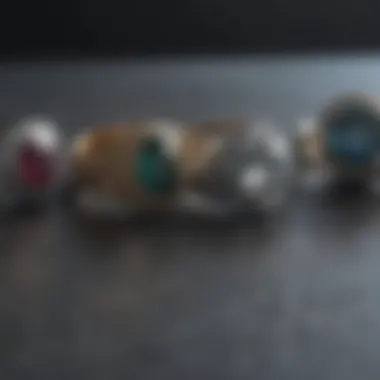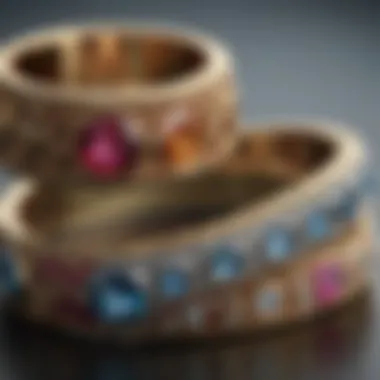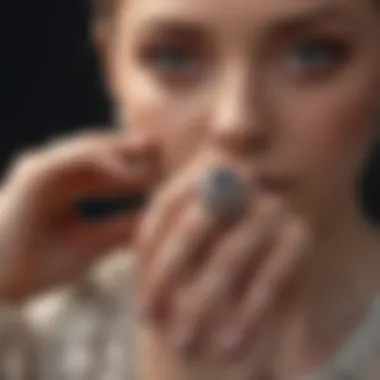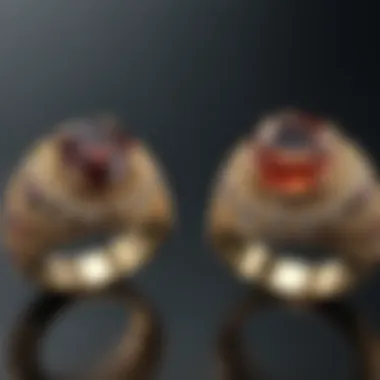The Order of Rings: How to Wear Them Effectively


Intro
Wearing rings is more than just a fashion choice; it encompasses tradition, symbolism, and an understanding of social norms. The nuances of ring etiquette can sometimes be overlooked, yet they carry significant meaning in various cultures. This guide aims to clarify how to wear rings with style and respect, touching upon traditional hierarchy, cultural variations, and personal preferences.
The purpose of this article is to provide a solid foundation for readers keen on understanding the intricacies of ring wearing. From the order of rings on fingers to how each piece might signify different aspects of one’s life, an informed approach can elevate one's jewelry experience.
Moreover, the significance of materials and styles is also examined. Engagement rings, wedding bands, and fashion rings each have unique contributions to personal expression. Whether it is a simple band or an elaborate design, knowing how to pair these effectively is crucial both for the wearer and the observer.
Understanding Ring Etiquette
Understanding ring etiquette begins with the acknowledgment of the rings' physical and cultural significance. In many cultures, the left hand holds different meanings than the right, especially concerning engagement and marriage. Wearing rings in specific orders or combinations can convey respect and adherence to tradition.
Traditionally, engagement rings are worn on the fourth finger or the ring finger. In many Western cultures, it is customary to wear wedding rings on the same finger, often stacked atop one another. The practice of layering signifies commitment and the intertwining of lives.
Conversely, fashion rings, which are often bold and colorful, can be worn on any finger. This flexibility allows individuals to express themselves freely, reflecting personal style without the weight of cultural obligation. However, this does not negate the importance of understanding when and how to combine different ring styles.
Cultural Variations
Cultural differences greatly influence ring etiquette. In some cultures, the engagement ring is worn on the right hand, while in others, it is common to wear no rings at all for engagement. This diversity emphasizes the need to be mindful when wearing rings, particularly in social settings where customs may differ.
- European Cultures: Often view a wedding band on the left hand as the norm, while engagement rings may be worn on the right.
- Asian Cultures: Some cultures do not traditionally use engagement rings but may prioritize other jewelry pieces.
Understanding these distinctions helps one navigate the complexities of ring etiquette effectively, enhancing mutual respect in cross-cultural scenarios.
"Jewelry has its own language. To wear a ring properly is to convey meanings that resonate well beyond mere aesthetics."
Pairing and Layering Rings
Pairing rings effectively is an art form that requires a thoughtful approach to aesthetics and significance. Here, personal style meets cultural understanding. The harmony of both elements can create a balanced and visually pleasing result.
- Material Matters: The metal's color and texture can change the overall kit. Consider how gold, silver, and platinum interact not just with your skin tone but also with each other.
- Balance the Size: Mixing rings of differing sizes can create dimension. Avoid overcrowding a single finger, which may divert attention from each piece’s unique qualities.
- Mind the Occasion: Formal settings may call for simpler combinations, while casual events allow for bolder displays.
Understanding Ring Etiquette
Understanding ring etiquette is essential for proper jewelry wearing practices. Rings can hold significant meaning in various cultures and personal contexts. The way rings are worn often reflects societal norms, emotions, and personal beliefs. Given the rich history associated with rings, proper etiquette carries heavy weight.
Wearing rings in a specific order signifies various stages in life events—like engagement and marriage. For many, these moments symbolize commitment and love. Thus, appreciating ring etiquette contributes to cultural awareness. It allows individuals to engage respectfully with traditions. Ignoring these customs may lead to misunderstandings or offend others.
The Significance of Ring Placement
Ring placement varies significantly. It can denote relationship status or personal beliefs. For example, the engagement ring is traditionally worn on the left hand's fourth finger in many Western cultures. This placement symbolizes love and commitment. Conversely, in some countries, the wedding band is worn on the right hand, altering the meaning associated with its placement.
This indicates that understanding ring placement is crucial for conveying the right message. A simple adjustment in how rings are worn can reflect respect for customs. Furthermore, individuals often want to express their personal preferences while adhering to these customs.
Cultural Variations in Ring Wearing
Cultural context shapes how rings are perceived and worn. Different traditions offer unique perspectives on the significance of rings.
Western Traditions
In Western cultures, wearing engagement rings on the left hand is a common practice. The choice of the left hand comes from the belief that this finger has a direct vein leading to the heart. This tradition enhances the emotional significance of the engagement ring.


Moreover, wedding bands frequently feature complimentary designs to signify unity with the partner. This practice is beneficial because it creates a visual representation of commitment. However, some may find the strong emphasis on traditional practices limiting.
Asian Influences
In various Asian cultures, the approach to ring wearing differs. For instance, in some societies, wearing a ring on any finger might signify engagement or marriage, depending on symbolism evident in local customs.
Rings may also serve as family heirlooms passed down generations. This highlights familial connection over individual representation. The unique feature of this is the emphasis on lineage and collective history. Some may find this collective approach disadvantageous, as individual expression may become secondary to family heritage.
Middle Eastern Practices
Middle Eastern customs often include ornate and elaborate rings. These rings may be used to express wealth and status, along with personal milestones. The significant aspect here is the cultural pride associated with such jewelry. Rings are often gifted during important life events, representing wealth and generosity.
This practice is beneficial as it fosters interpersonal relationships through gifting. However, it may also place pressure on individuals to acquire more extravagant ring designs to maintain or elevate social status.
Overall, whether one embraces Western traditions, Asian influences, or Middle Eastern practices, understanding ring etiquette helps navigate cultural sensitivities surrounding jewelry, offering insight into the complexities of how rings are worn.
Common Ring Types and Their Meanings
Understanding the different types of rings is essential for anyone interested in jewelry. Each type holds unique significance and embodies various emotions and traditions. Recognizing these meanings can enhance one's appreciation for rings, whether worn or observed. This section aims to provide clarity on common ring types, their symbolism, and the cultural contexts in which they are situated.
Engagement Rings: Symbolism and Placement
Engagement rings symbolize commitment and love. Traditionally, they are presented during a proposal, marking the beginning of a couple's journey towards marriage. The ring is typically worn on the fourth finger of the left hand, known as the ring finger. This practice stems from the belief that a vein in this finger leads directly to the heart, a sentiment that enhances the emotional value of the ring.
The style of engagement rings varies widely. Some may prefer classic solitaire diamonds, while others lean towards intricate designs featuring multiple stones. The choice often reflects personal taste and the value placed on certain materials. Diamonds are commonly associated with engagement rings due to their durability and brilliance, serving as a metaphor for the strength of the bond.
Wedding Bands: Order of Wearing
Wedding bands are often exchanged during the marriage ceremony, signifying the couple's union. The placement of the wedding band typically occurs after the engagement ring. This arrangement is rooted in tradition, where the wedding band, being an unbroken circle, represents eternal love.
When wearing both an engagement ring and a wedding band, the traditional stacking order is to have the wedding band closest to the heart, followed by the engagement ring. While this holds for many, personal preferences can dictate different arrangements. Rings can be worn on different hands or fingers based on comfort or aesthetic choices, which allows for individual expression within the framework of tradition.
Fashion Rings: Personal Expression
Fashion rings, unlike wedding or engagement rings, serve primarily as personal expressions of style rather than symbols of marital commitment. These rings come in an array of designs, including statement pieces, stackable rings, and those featuring colorful gemstones. They allow wearers to showcase their personality and creativity.
Fashion rings afford wearers the flexibility to mix and match. Pairing fashion rings with classic styles can create an appealing contrast. This type of ring is commonly worn on any finger, supporting diverse looks and styles, making them an essential part of modern jewelry wear. Fashion rings can also reflect current trends, adapting to cultural shifts in the fashion industry.
Traditional Orders for Ring Wearing
Understanding the traditional order of wearing rings is significant. It reflects cultural norms, personal choices, and the emotional connections tied to specific pieces of jewelry. This section provides insights into how rings are typically worn, guiding readers through the established practices that influence current trends in ring wearing. By examining these traditions, both wearers and observers can appreciate the meanings that each placement conveys.
The Classic Stack
Engagement Ring First
The practice of wearing the engagement ring first is deeply rooted in tradition. This placement signifies the promise made during the engagement phase, underscoring its importance. People often choose this order because it highlights the ring’s symbolism of love and commitment, making it the first and foremost statement of the wearer's relationship status.
One key characteristic of wearing the engagement ring first is its visibility. When displayed prominently, it draws attention and allows for a conversation starter about the engagement story. However, it can create a slight challenge when adjusting or adding a wedding band, as it may require special consideration for size and comfort.
Another advantage is the emotional value associated with the engagement ring. As the initial promise of commitment, it carries sentimental weight, making its first position a common and respected choice.


Wedding Band Second
Following the engagement ring with the wedding band is a widely accepted custom. The wedding band symbolizes the union and enduring commitment between partners. Its placement after the engagement ring emphasizes the continuity of love and partnership.
A notable aspect of wearing the wedding band second is its design simplicity. Many opt for a plain band that complements the engagement ring. This minimalist approach can enhance the elegance of both pieces. However, some might find that combining the two rings creates bulkiness, which can influence comfort and overall aesthetics.
The wedding band also has a unique feature: it often represents the formalization of the relationship. This lends the band significant emotional and symbolic value, solidifying its importance in the hierarchy of ring wearing.
Alternate Customs in Different Cultures
Left Hand vs. Right Hand
The choice between wearing rings on the left hand versus the right hand varies across cultures. In many Western traditions, the left hand is preferred for engagement and wedding rings. This choice stems from the belief that the left hand contains a vein that leads directly to the heart, enhancing the romantic symbolism of these rings.
Conversely, many cultures, including some Eastern traditions, favor the right hand for these symbols of commitment. This difference highlights cultural values surrounding love and marriage. It can also reflect personal preferences, making the topic more than just tradition but also an expression of identity.
A unique consideration of this debate lies in the meaning tied to each hand. Wearing on the left may denote a more traditional view, while the right may symbolize a progressive or alternative stance on love and partnership.
Traditions by Region
Cultural practices regarding ring wearing can vary significantly depending on regions around the world. For example, in Russia and some Eastern European countries, wedding rings are worn on the right hand as a sign of commitment. This represents a rich cultural history tied to the value placed on love and family.
In India, the concept of ring wearing also varies. Traditionally, women may wear a ring on a specific finger known to denote marital status, which differs from Western practices.
These regional differences create a diverse tapestry of customs, showing that traditions in ring wearing are closely linked to cultural identities and values. Each region brings unique features that contribute to the overall understanding of jewelry etiquette, allowing for individual expression while respecting deep-seated customs.
Modern Interpretations of Ring Wearing
In today's dynamic world, the way individuals wear rings has evolved significantly. Modern interpretations of ring wearing reflect not just personal style but also attitudes towards tradition and individuality. Understanding this evolution offers valuable insights into how people express themselves through jewelry. This section discusses personal preferences in ring arrangement and the influence of fashion trends on ring placement, forming a comprehensive overview of contemporary ring wear.
Personal Preferences in Ring Arrangement
Personal preference plays a crucial role in how individuals choose to arrange their rings. Each person's taste varies widely, resulting in unique styles that cater to personal aesthetics. Some may prefer minimalist designs, while others embrace a more eclectic stacking method.
Factors influencing personal choice include:
- Lifestyle: Active individuals might opt for simpler ring designs that can withstand daily wear.
- Symbolism: Rings that represent significant milestones may hold a special place, leading to a priority in placement.
- Occasion: Some may choose to wear different rings for various events, adjusting their arrangement according to social settings.
Ultimately, personal preferences determine how rings are worn, allowing for a statement about one's identity and values.
Influence of Fashion Trends on Ring Placement
Fashion trends significantly impact how rings are worn today. Designers often introduce new patterns, colors, and arrangements, leading to fresh perspectives on traditional customs.
Several key elements shape the current landscape of ring fashion:
- Layering: The stacking of multiple rings has gained popularity, making it common to see different ring styles worn together. This trend allows for individualized expression and creativity.
- Mixing Materials: There is a growing trend to combine various metals and gemstones in unconventional ways. This not only enhances visual appeal but also encourages personal storytelling through jewelry.
- Social Media Influence: Platforms like Instagram and Pinterest have become significant sources of inspiration for ring arrangements. Users share their styles, prompting others to experiment with their placements.
Practical Advice on Ring Pairing
Understanding how to pair rings effectively is crucial for both aesthetics and personal expression. This section presents practical advice that caters to the needs of gemstone enthusiasts, collectors, jewelry designers, and geology enthusiasts. The significance of complementary styling cannot be overstated. A well-paired set of rings can elevate an outfit and convey a specific message. Both the visual and emotional aspects of ring pairing play a vital role in one’s overall style.


When selecting rings to wear together, consider not just personal taste but also how each piece interacts with the others. The right pairing can create a cohesive look that highlights individual stone properties or design elements. Proper guidance on pairing can prevent mismatched styles that confuse the overall aesthetic.
Choosing Complementary Styles
Complementary styles are essential for a visually appealing ring arrangement. Rings that enhance rather than compete with each other will always look better. To achieve harmony, consider the following aspects:
- Design Cohesion: Rings that share similar design elements like patterns or themes create uniformity. For example, stacking geometric shapes or nature-inspired designs can yield an elegant look.
- Size Variations: Mixing rings of different widths and thicknesses helps create dimension. A thick band can balance out a more delicate, thinner ring.
- Shape Compatibility: Incorporating rings of varying shapes may usher in an interesting silhouette. Rings that accentuate distinct shapes can become focal points.
When selecting styles, it might be beneficial to organize the rings either by color or gemstone type as well. This strategy aids in forming a unified narrative for the wearer's jewelry collection.
Color and Material Considerations
The interplay between colors and materials is another key component in effective ring pairing. The psychological effects of colors can influence mood and perception. When considering materials, think about the properties of each metal or gemstone you plan to wear.
- Metal Types: Different metals like gold, silver, and platinum have various qualities. By choosing metals that complement one another, a harmonious aesthetic emerges. For instance, pairing warm-toned gold with cooler-toned silver can create a striking contrast.
- Gemstone Colors: The color wheel offers insights into color harmony. Colors that are opposite on the wheel, like blue and orange, can create an eye-catching combination while those that are analogous, such as blue and green, offer a more subtle, cohesive blend.
- Finish and Texture: Consider the finish of your rings, whether polished, matte, or hammered. Mixing finishes adds depth. Smooth finishes can complement textural rings to enhance their unique features.
A well-executed ring pairing can significantly contribute to one's overall style. The details discussed here not only optimize visual appeal, but they also underscore the reverence for jewelry as an art form.
"The beauty of jewelry lies not just in its material value but in its ability to tell a story through careful expression and style choices."
Pairing rings may seem straightforward, but thoughtful consideration of styles, colors, and materials will enhance one's jewelry presentation. As trends evolve, keeping these practical tips in mind empowers wearers to create personalized yet elegant arrangements.
Caring for Multiple Rings
Wearing multiple rings can make a strong personal statement and enhance one's style. As the trend of stacking and mixing various rings continues to gain popularity, understanding how to care for them is essential. Rings made from different materials may require distinct cleaning and maintenance methods. Proper care preserves their appearance and ensures longevity, which, for gemstone enthusiasts and collectors, is vital. Knowing how to handle and store these pieces safeguards not just their beauty, but also their emotional and financial value.
Cleaning and Maintenance Tips
To keep multiple rings looking their best, regular cleaning is necessary. However, each type of ring may need a different approach.
- Use Appropriate Cleaners: For gold and silver rings, a gentle soapy solution is often enough. Avoid abrasive cleaners. For gemstone rings, check if the stone has specific care instructions. For example, pearls require milder cleaning methods.
- Soft Cloths: Use a soft, lint-free cloth for polishing. This will remove minor smudges without scratching the surface. Avoid paper towels which may cause scratches.
- Ultrasonic Cleaners: Consider investing in an ultrasonic cleaner for deeper cleaning. These devices safely remove dirt and grime but should only be used on durable stones, as some may not withstand ultrasonic waves.
- Inspect Regularly: Regular inspections for loose stones or damaged settings help catch potential issues early. Make a point to check the condition of each piece and address problems right away.
Keeping the rings clean not only maintains their brilliance but also aligns with caring for their intrinsic value.
Storage Solutions for Rings
When not worn, proper storage of multiple rings is crucial to prevent damage and tangling. Here are some effective methods:
- Ring Boxes: Use a dedicated ring box with cushioned interiors. This protects against scratches and exposure to air, which can cause tarnishing.
- Separate Compartmentalization: If possible, store rings in individual compartments to prevent them from scratching each other. This is especially important for rings with gemstones.
- Avoid Humidity: Store rings in a cool, dry place. Humid environments can accelerate tarnishing and degradation of certain materials.
- Consider a Jewelry Roll: For travel, a jewelry roll provides compact storage without tangling up the rings. Ensure that it has soft fabric compartments to prevent movement.
Maintaining careful storage habits ensures that each ring is preserved in optimal condition for years to come, ready to be worn at a moment's notice.
Closure: Finding Your Personal Style
Understanding how to wear rings not only involves adherence to traditional norms but also allows for significant personal expression. In contemporary society, the boundaries that defined ring etiquette are increasingly fluid. As such, finding your personal style can be an enriching experience, allowing individuals to showcase both their unique identity and their appreciation for jewelry.
Reflecting Individuality in Ring Choices
When selecting rings, many individuals look to incorporate elements that reflect personal stories or milestones. This can pertain to choices in style, material, and even color. For gemstone enthusiasts and collectors, the significance of a piece might be amplified by the story behind it – whether it be the provenance of a particular stone or the craftsmanship of the setting.
Expressing individuality through rings can also be done by deliberately breaking from convention. Some may choose to wear an engagement ring on the right hand instead of the left, opting for styles that resonate more with their aesthetic preferences than with societal expectations.
In recent years, the trend of customizing rings has gained traction, allowing individuals to create pieces that truly encapsulate their essence. Customization can involve selecting specific gemstones, settings, and metal types, resulting in a unique piece that symbolizes one’s distinct journey.
Respecting Traditions While Embracing Change
Traditions surrounding rings can be deeply rooted in cultural practices and familial customs. Engaging with these traditions fosters a sense of connection to one's heritage. However, it is essential to recognize that traditions can evolve. Embracing change does not mean disregarding the past; rather, it means integrating historical significance with contemporary values.
For example, many now opt for alternative engagement or wedding rings that diverge from traditional diamond choices. Stones such as sapphires or emeralds are becoming increasingly popular, reflecting a desire to personalize one’s commitment while respecting the symbolic meaning behind the ring. This trend shows how traditions can coexist with modern sensibilities, creating a blend that honors both history and personal preference.







